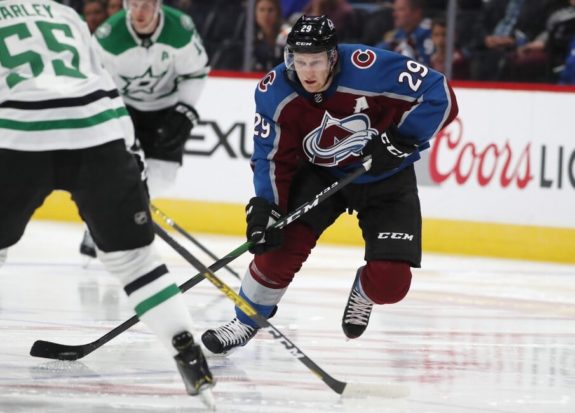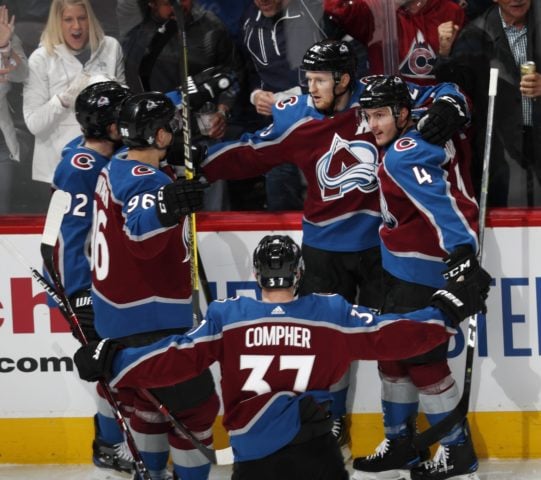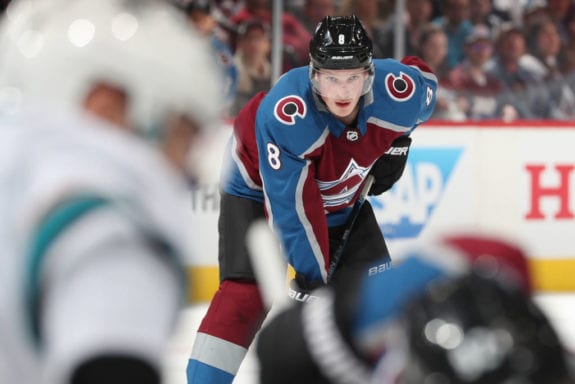The Colorado Avalanche persevered through much adversity this season. They lost hundreds of man-games to injury, and it seemed like every week another star player was getting hurt. Checking- and fourth-line players were forced onto scoring lines, and there were several minor league call-ups in February and March.
When the league suspended play in March due to the coronavirus pandemic, the Avalanche were in second place in the Western Conference, only two points behind the St. Louis Blues. If the league un-pauses the season, the Avalanche have a chance to accomplish something that no Western Conference team has done since 2011, succeed despite significant injuries.
Related: The Worst Teams in Stanley Cup History
Every team deals with injuries, and deep teams are often the ones that make it the furthest. This season, the Avalanche’s scoring was spread out.
Per usual, Nathan MacKinnon led the team in all offensive categories with 35 goals and 58 assists. The next highest scoring teammate was rookie sensation, defenseman Cale Makar (12 goals, 38 assists). However, 16 players scored at least 20 points, and the team ranked third in the NHL in goals scored.

What makes this stat more incredible is who was injured while the team kept scoring. The Avalanche weren’t just hit by the injury bug; they were swarmed by mosquitoes who had a taste for the team’s best (and most expensive) players. The eight highest paid forwards on the team, by salary cap hit, missed 22.8% of the season, and five of those eight skaters suffered injuries between Feb. 9 and Mar. 9.
Nazem Kadri (injured Feb. 9), Matt Calvert (Feb. 15), Mikko Rantanen (Feb. 15), Andre Burakovsky (Feb. 21, re-injured Feb. 28), MacKinnon (March 9) were all expected to return before the end of the regular season. Gabriel Landeskog was out from Oct. 6 to Dec. 5, but had long since returned when the season was suspended. J.T. Compher and Jonas Donskoi also missed a handful of games but were in the lineup at the break. Additionally, Makar — not part of the top eight – was injured on Feb. 29 but returned to action on March 11.
Converting Avalanche Injuries to Points in Standings
To determine the value of the loss of player contributions, we need to convert goals for/against into team wins/losses. Point Shares (PS) is a metric re-invented by hockey-reference.com that translates offensive and defensive production into points in the standings, allowing us to project a team’s points during the season. The stat compares time-on-ice and expected goals to the league average to determine a player’s contribution.
Table 1. Top eight Avalanche skaters in terms of salary cap hit for 2019-20 season.
| Player Name | Salary Cap hit ($ millions) | Games Played (GP) | Games Missed | PS Total | PS/GP | PS lost to injury |
| Andre Burakovsky | 3.25 | 58 | 12 | 5.4 | 0.08 | 0.93 |
| Matt Calvert | 2.85 | 50 | 20 | 3.0 | 0.04 | 0.86 |
| JT Compher | 3.50 | 67 | 3 | 2.6 | 0.04 | 0.11 |
| Jonas Donskoi | 3.90 | 65 | 5 | 3.1 | 0.04 | 0.22 |
| Nazem Kadri | 4.50 | 51 | 19 | 4.2 | 0.06 | 1.14 |
| Gabriel Landeskog | 5.57 | 54 | 16 | 4.6 | 0.07 | 1.05 |
| Nate MacKinnon | 6.3 | 69 | 1 | 10.8 | 0.15 | 0.15 |
| Mikko Rantanen | 9.25 | 42 | 28 | 4.6 | 0.07 | 1.84 |
| Total | 39.1 | 456 | 104 | 38.30 | 0.55 | 6.30 |
Since one PS equals one team point, we can expect that losing these players for 104 games cost the team 6.3 points in the standings. This is significant because the Avalanche are two points behind the St. Louis Blues for the top seed in the West.
Not only did injuries cost the Avalanche points in the standings, but they were also very expensive. However, it’s important to understand the metric I used and its historical significance to the Avalanche’s experience this season.
First, a disclaimer: I understand that a player’s contract in any given season doesn’t necessarily equal his value to the team. There are many young players on their entry-level deals who perform better than aging veterans on expensive, back-loaded contracts. Examining cap hit league-wide across a decade, the effects of those instances become smaller because of the larger sample size. With that out of the way, we can dive into the numbers.
Cap Hit of Injured Players
There’s a metric developed by the blog NHL Injury Viz called CHIP, or “Cap Hit of Injured Players,” that standardizes the per-game cost (in USD) of a player’s injury. For example, Andre Burakovsky. His cap hit was $3.25 million this season, so each game (whether he played or not) cost the team $3.25 million / 82 games = approximately $39,600. He missed 12 games due to injury, in “cap hit value”, that injury time cost the team 12 games * $39,600/game = approximately $476,000. The Avalanche’s total cap hit lost to injuries this season is around $11.3 million.

To contextualize the significance of the Avalanche’s CHIP this season, I examined how that number compared to playoff teams from both conferences from 2011-19. For consistency, I only used data from NHL Injury Viz, which has data from 2011-20. Since just over half the NHL makes the playoffs each season, I wanted to focus a bit. The first comparison is how the Avalanche fared versus seeds one through four in each conference.
Related: NHL’s 5 Best Agitators of the Decade
From 2015-20, only three playoff teams seeded 1-4 in either conference had a regular-season CHIP higher than the Avalanche: 2018 Winnipeg Jets, 2 seed, $11.6 million; 2017 Pittsburgh Penguins, 2 seed, $12.5 million; 2016 St. Louis Blues, 2 seed, $11.7 million. That’s three teams out of a possible 47 playoff seeds, or 6.4%. That is rarefied air, but since the Avalanche are more than just playoff contenders, I wanted to know how they would stack up against conference and Stanley Cup champions.
Prime Spot to Make History
Table 2 below displays the teams who finished with the best regular-season record from each conference from 2011-2019 (I excluded the 2019-20 season because it isn’t officially canceled). No team from that time period had more lost CHIP than the 2019-20 Avalanche, and the average Western Conference regular-season winner only lost about half of what the Avalanche lost this season. (CHIP referenced below is in US$ million).
Table 2. Regular Season champions, 2011-2019.
| Season | Western Conference 1 seed | CHIP | Eastern Conference 1 seed | CHIP |
| 2019 | Calgary Flames | 6.1 | Tampa Bay Lightning | 6.2 |
| 2018 | Nashville Predators | 4.3 | Tampa Bay Lightning | 5.4 |
| 2017 | Chicago Blackhawks | 4.9 | Washington Capitals | 1.8 |
| 2016 | Dallas Stars | 5.1 | Washington Capitals | 5.4 |
| 2015 | Anaheim Ducks | 7.6 | New York Rangers | 6.9 |
| 2014 | Anaheim Ducks | 11.0 | Boston Bruins | 6.2 |
| 2013 | Chicago Blackhawks | 3.9 | Pittsburgh Penguins | 5.4 |
| 2012 | Vancouver Canucks | 6.9 | New York Rangers | 6.2 |
| 2011 | Vancouver Canucks | 8.6 | Philadelphia Flyers | 4.4 |
| Average CHIP | 6.5 | 5.3 |
Table 3 below depicts each conference’s playoff champion, i.e. the two teams that faced each other in the Stanley Cup Final (the teams in bold are the Stanley Cup champions).

Only one team out of 18 possible teams lost more cap hit value than the Avalanche (Penguins, 2017), and coincidentally, they won the Cup that season.
Table 3. Stanley Cup Final matchups, 2011-19.
| Western Conference | Eastern Conference | |||
| Season | Champion | CHIP | Champion | CHIP |
| 2019 | St. Louis Blues | 9.5 | Boston Bruins | 9.5 |
| 2018 | Vegas Golden Knights | 8.7 | Washington Capitals | 3.3 |
| 2017 | Nashville Predators | 6.0 | Pittsburgh Penguins | 12.5 |
| 2016 | San Jose Sharks | 5.0 | Pittsburgh Penguins | 10.6 |
| 2015 | Chicago Blackhawks | 5.7 | Tampa Bay Lightning | 6.5 |
| 2014 | LA Kings | 4.6 | New York Rangers | 6.9 |
| 2013 | Chicago Blackhawks | 3.9 | Boston Bruins | 1.9 |
| 2012 | LA Kings | 5.6 | New Jersey Devils | 8.2 |
| 2011 | Vancouver Canucks | 8.6 | Boston Bruins | 5.7 |
| Average CHIP | 6.4 | 7.2 |
If the NHL season restarts, then the Avalanche are primed to complete their historic season. Several of its injured stars – Rantanen, Kadri, and MacKinnon to name a few – were expected to return by late March and so they should be healthy if/when the season continues. If the Avalanche wins the top seed in the West, they’ll become the first team in at least the past ten seasons to do so with a CHIP of $11.3 million.
Maybe it’s not the same with this season’s big break to rest their players, but the Avalanche showed that their future is bright and the on-ice product is in elite company. Imagine how good the team will be when it’s fully healthy.